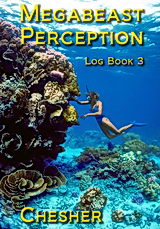The Crown of Thorns Strikes Again
We lengthen our interval of awareness, perceive new levels of change.
Four large crown-of-thorn starfish graze on the side of the plate coral. I hover above them in the clear lagoon water. My old enemy, Acanthaster planci. The plate coral colony is about 2 meters from side to side. It must be at least 50 years old. The starfish are slowly eating the coral, having already eaten most of the other corals in the vicinity. When two of them link arms, they can digest the coral more efficiently, linking their stomachs and digestive juices in a kind of feeding frenzy. A slow feeding frenzy. Normally they feed at night but when their population numbers are high, they feed all the time.
I swim along the edge of the reef and count 26 more crown-of-thorns.
"Rick, come have a look," Freddy calls from up on the shallow flat.
She has found a baby crown-of-thorns, about 30 millimeters in diameter, under a rock on top of the reef. I peek under some nearby dead coral rocks and find another three.
"Looks like there are a whole bunch of year classes, Damn." One big crown-of-thorns is eating a gorgeous plate coral just under me. The starfish must be 4 or 5 years old and is at least 35 centimeters in diameter. Its long poisonous spines are banded red and green. They flop over every which way. They look soft, but the spines are so sharp it is impossible to feel the end without it penetrating the skin. I've seen electron-microscopic views of the tip of the spine and it tapers to a molecular point of calcium carbonate crystal. I've also been pronged by them and know well the poison in the soft skin.
The crown-of-thorns has wrapped it's 16 arms around the edge of the plate coral. They can fold their soft body into any form at all. I pull out my diving knife and gently pry loose one of the arms. Acanthaster uses thousands of little, suckered tube-feet to pull its yellow stomach out of its mouth. It arranges the stomach over the living tissue of the coral like a blanket, tucking it into the folds and crevices of the coral. Then the stomach secretes digestive enzymes and digests the coral polyps in their little cups.
I can see the stomach stuffed into the interstices of the coral, the gleaming white skeleton of the coral is already exposed. I remember taking time lapse underwater movies of Acanthaster in Guam. They showed the beast running across the sea floor like a weird monster from inner space. It leaped on the coral and sucked down onto it as it pulled the stomach out of the central disk. It wiggled around delightedly as it drank the life of the coral. When done, it slurped in its stomach and raced off.
I swim along, looking at the broad area of dead coral. The coral skeletons are still standing in positions of growth, but the colorful living coral flesh is gone. The coral skeletons are overgrown with algae. The colorful reef fish no longer fit into this environment and have gone elsewhere. Or maybe they've been eaten by predators. The reefs look awful. Dead. Lots of Crown of Thorns starfish gobble up what's left of the tropical opulence.
There is a small basin on the reef, not far from the anchorage, where the coral is still OK. It's quite pretty there, although the starfish are converging on it from all sides.
"We'll need to clean them out," I say to Freddy as we climb back into Zod. "Maybe Dick Smith will help out." It is important to keep the little coral garden alive. I need it.
I want to make a pictorial outline about This Magic Sea. I can tell someone about This Magic Sea in about 45 minutes. Of course, nobody but Yves has ever understood what I was talking about. If I can say it shorter, say in 20 minutes, maybe people will understand. I figure I can reduce the telling time and make it more clear if I have the appropriate photographs to show what I'm talking about.
I already have photographs for some of the outline. The series of phrases from the past six months have started to come together. I need to work out the whole outline and figure out how to put all the phrases and photographs together into one short, clear presentation about This Magic Sea. And I need this particular living coral reef to do it.
There are levels of behavior hominids simply can't perceive directly. By altering the fields of perception - by changing our normal terms of symmetry or time interval - invisible behavior becomes self-evident. Anyone who has watched a flower opening in time lapse or seen a vine growing up a tree done in extended time lapse knows right away they have seen another perspective of life: something brand new and different from the normal human view.
Suppose, for instance, I show the communication web of a coral by photographing it twice a day for 90 days and then project the slides at 16 frames per second. When we look at a coral on a reef it appears to be a static, unmoving thing. But in time lapse we will see it moving - forming a tunnel in Sea. We will see the coral take in Sea and sunlight and turn it into its own diaphanous flesh and we will see the flesh form the crystal skeleton. The series of photographs will be a time lapse demonstration of the behavior zone concept.
But I can't do that if a damn starfish gobbles up my coral's communication web with its own.
Freddy and I go ashore to talk to Dick Smith and the owner of Plantation, Reg Raife.
"Aw, not to worry," says Dick, "These things come and go. I read a article by Ron Taylor in National Geographic. He says its a natural cycle and nothing to worry about."
"Well, maybe yes, maybe no. There have been people saying its a natural cycle for twenty years now and it's still going on and getting worse. What difference does it make if it's a natural cycle? Insects devastating a garden can be a natural event, too. That does not mean you should simply let them gobble your crops? Especially when the insects are over a foot in diameter and reasonably easy to clean out of the garden? Your coral reefs are an important draw for the tourists. People want to see live coral reefs, not dead ones. It wouldn't take much effort to clean them out. Then your reefs will improve and become healthy again. You might even make it a kind of special project for those guests who like to dive."
"What and call attention to the idea our reefs might have a problem? Forget it." Dick closes the subject.
Freddy and I walk down the path to Plantation to talk with the owner, Reg, and his wife Ellie. They are more interested in the subject. I show him a copy of the March 1970 National Geographic article about the massive U.S. research project on the Crown-of-Thorns starfish. "That's me, there," I point to the photo of myself on page 345. It says I am Chief Scientist of the special Department of Interior study.
The map of Guam, next to my photo, shows where we found massive hoards of the starfish. "There was a band of these starfish three kilometers long, hundreds of thousands of them, arm to arm, eating up the living coral from the intertidal zone to the deepest depths of coral growth at the rate of one kilometer of coastline per month."
"Ohh, that is interesting. Do you think that could happen here in Fiji?" Ellie asks.
"It could, but the situation here is different. There are many different age groups out there on the reefs. Some areas look like the starfish ate the coral years ago, others are being eaten now. But it is clear the reefs are not as spectacular now as they were in the recent past." I shift around to look at Reg. He is in his sixties. Ellie is much younger.
"I've heard people say the reefs seem to be worse these days, but we had no idea why. What causes the population explosions?" Reg asks. "I seem to remember hearing the scientists concluded it was a natural cyclic event."
"I don't agree and neither did the sixty odd scientists who participated in the survey of the North Pacific. The actual cause of the infestations is a bit complex but I can sum it up with an analogy. OK?"
"Of course," Ellie answers.
"Cancer. The crown-of-thorns starfish explosions are like a cancer of the reef. Determining what causes cancer is, as you know, very difficult. Nobody knows, for sure, exactly what causes cancers in humans and humans are the best studied biological system on Earth.
"Many doctors agree stress is an important factor. They also agree different cancers can be caused by different kinds of physiological stress; like smoking, chemical toxins, irradiations of various sorts.
"The cells of a person's body maintain the form and function of the body's tissues by a very complicated communication network. If a group of cells get cut off from this communication network, they stop being part of the person and become independent, raging lunatics, eating up everything in sight. The control systems, the immune systems, of a normal, healthy person will attack and kill these crazy cells. But if they fail, the cancer cells grow wildly, eating other cells for food. One part of us literally eats up the rest of us.
"This is exactly what happens with the crown-of-thorns starfish. It has been a cell on the coral reefs of the Indo-Pacific for almost as long as there have been reefs. It is a normal part of the reef system and a wide variety of controls ranging from bacteria to crabs and shrimp and triton shells and fishes of various sorts work in concert to maintain the starfish populations at a reasonable level."
"What's a reasonable level?" Reg asks.
"On reefs remote from humans, there may be one crown-of-thorns per 5 or 6 kilometers of reef. Many reef surveys in remote areas, and those made over twenty years ago, found no crown-of-thorns at all over large tracts of coral. Occasionally, in natural situations, small populations of up to 20 starfish congregate near reef passes."
"You were saying about cancer?" Ellie gets me back on track.
"Doctors say every human can expect to have about 100 cancers in a normal lifetime. But the body of a healthy person can fight these off and reassert control by the simple process of having unaffected cells eat the crazy ones. When the body is stressed, however, the cancer gets completely out of control and munches up the person. Unless a surgeon cuts it out in time.
"Geological evidence from the Great Barrier Reef indicates the crown-of-thorns population has always undergone fluctuations. From time to time there will be an excellent breeding season and many of these starfish might appear. On a normal healthy reef, the predator control systems promptly begin to nibble away at the population and before the starfish reach breeding age, they are gone.
"But
these days, the reefs are stressed anywhere near centers of people.
The triton shells, each of which can eat several small starfish every
night, are picked up to sell to tourists. The big fish that eat crown-of-thorns
starfish have been caught. The corals themselves have accumulated long
lasting pesticides like DDT in their tissues. When the starfish eat
the corals they also ingest the DDT. The poison accumulates in their
own tissues. DDT and other similar chemicals don't seem to bother the
starfish. But if a shrimp, crab or triton shell eats contaminated starfish,
the dose of DDT is enough to kill the predator."
"So you think pesticides are the cause?" Ellie asks.
"No. They contribute to the problem, but the reefs are stressed from all these things and perhaps others as well. Even natural causes like storms stress the reefs. The interaction of all the stresses with the starfish creates the crown-of-thorns cancer. If the cancer is unchecked, the population snowballs year by year. Larger and larger numbers of starfish appear on the reefs. They group together to spawn. The next year, if it is a good year for the larvae, hundreds of thousands of starfish can settle on the reefs.
"The budding cancer might fizzle out or it might develop into a major cancer and wipe out miles and miles of reef. Like in American Samoa, Rarotonga, Guam, Saipan, Australia and lots of other places."
"Or it might not," Argues Reg. "On the other hand, it would not be good publicity to organize a major clean-up effort here. People would think the reefs were not as good as our competitors."
"True, that's a good point. What's going on here is not new. It has been going on for some time. I've discovered the reefs at Mana Island are much better than they are here. Your competitors at Mana Resort - the Japanese owners - know about the starfish from major infestations in some of Japan's southern islands. I understand a couple of local guys on the staff clean out the starfish every so often. The result is they have better corals, more fish, and more customers. It wouldn't take much, really. Just a couple of guys quietly out there picking them out of the coral gardens."
"We'll see," he smiles, but his eyes say he does not intend to do anything.
Freddy and I walk back along the beach. "We'll just have to clear out the basin by ourselves," she says.
"Yes, we'll do that. It's too bad I couldn't get them to understand. They could improve the reefs around here with very little effort."
I discover a wonderful pattern in the sand created by water seeping out of the coral rock during low tide. "It looks exactly like a branching bush with the roots exposed," I point it out to Freddy. "The tributaries begin as tiny little twigs. They join here to form the larger branches and finally unite into major branches and then a trunk where the water runs quickly and deep. Then the pattern breaks up into roots where the slope of the beach reaches the normal low tide line. The roots move laterally and divide into smaller and smaller rootlets as the water seeps away."
"It looks like that satellite photograph of the Mississippi Delta: just like a giant bush." Freddy says and turns to go.
"It's one of those patterns From talks about in Catastrophe theory. The configuration of the shore, and the fluid energy rushing through a particulate system results in that bush pattern. It doesn't seem to matter if it's the Mississippi Delta or a little drainage on the beach. I wonder if we can think of sunlight streaming through earth atoms forming bushes in the same way. Some aspect of energy flowing through large populations of small particles predestines that form." I make a mental note to come back and get some shots of it as an illustration of parallel patterns - control systems.
Freddy puts her arm around my waist and gives me a kiss. I look down the gleaming white beach at the yachts anchored in the cove. Life could be worse.



